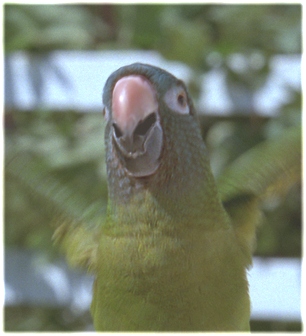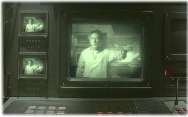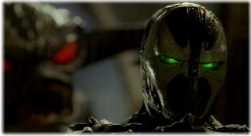

Supernova is a film that we have been working on since Hammerhead was founded in 1995. Dan Chuba wrote the script, and Jamie and Thad created a short trailer for the pitch that sold United Artists on the project. It was filmed this past spring and summer with Walter Hill directing, and James Spader and Angela Bassett in the leading roles. Our own Dan Chuba and Jamie Dixon produced the film along with the executive producer of Shadowbuilder, Ash Shah. Supernova is currently in post-production with a projected release date of January 2000. Most of the effects work was done at Digital Domain, with Hammerhead and a few other companies pitching in.
UA has put out a press release about Supernova.
Bram Stoker's Shadowbuilder is directed by Jamie Dixon, and was the first film that we produced at Hammerhead. It's a modestly budgeted live-action thriller with special effects used to create the Shadowbuilder and his minions. We filmed it in Toronto during the summer of '96, and we worked through the fall and early winter creating over 200 effects shots. The effects were a tremendous success; we hired a few good freelance people, trained them to use our own in-house tools, and did all the shots in a little over four months. This past year, Shadowbuilder was the closer at Spain's San Sebastian Horror Film Festival for which it garnered the coveted "Spiked Tic Award". It also won the "Silver Bat Award" for best visual effects at the Rome Fantafestival earlier this year. Shadowbuilder is now available for rental on vhs in video stores around the country, and is for sale in a DVD version with directors commentary and production notes. (Look for it at www.dvdshowcase.com)
In the four year history of the company, we've worked on over two dozen movies including: Deep Blue Sea, For Love of the Game, Practical Magic, Paulie, US Marshals, Sphere, Flubber, Spawn,Titanic, Batman and Robin, U-Turn, For Richer or Poorer, My Favorite Martian, Showgirls, A Vampire in Brooklyn, Nixon, Kazaam, Romeo and Juliet, Dragonheart, Up Close and Personal, The Birdcage, and several other films.
 For Deep Blue Sea,
we created computer generated sharks which matched the appearance of the
animatronics used during filming, and created exciting action sequences
to flesh out the story during post-production. Needless to say, with Hammerhead's
interest in all things shark, we were interested in the job from the start.
After Viewpoint Data Labs built a model to our specifications, Thad
created custom controls for it so that shark behaviors like swimming, or
baring teeth, could be addressed procedurally using our in-house 3D animation
system called Z. This enabled the animators to concentrate on the way the
sharks acted rather than on the technically correct relationship of shoulders
to body while swimming, for example. The sharks were rendered using RenderMan,
shaded with textures Rebecca painted in Photoshop, then composited
into background plate photography using matte, another in-house system.
In this final part of the process, depth filters were applied in the form
of fog, and we added blood, bubbles, particulate, shadows, and caustics
(rays of light shooting through the water from the surface) as each shot
needed.
For Deep Blue Sea,
we created computer generated sharks which matched the appearance of the
animatronics used during filming, and created exciting action sequences
to flesh out the story during post-production. Needless to say, with Hammerhead's
interest in all things shark, we were interested in the job from the start.
After Viewpoint Data Labs built a model to our specifications, Thad
created custom controls for it so that shark behaviors like swimming, or
baring teeth, could be addressed procedurally using our in-house 3D animation
system called Z. This enabled the animators to concentrate on the way the
sharks acted rather than on the technically correct relationship of shoulders
to body while swimming, for example. The sharks were rendered using RenderMan,
shaded with textures Rebecca painted in Photoshop, then composited
into background plate photography using matte, another in-house system.
In this final part of the process, depth filters were applied in the form
of fog, and we added blood, bubbles, particulate, shadows, and caustics
(rays of light shooting through the water from the surface) as each shot
needed.
For more Deep Blue Sea images visit the PEOPLE in DANGER or TIGER SHARK ATTACK pages.

In For Love of the Game, we created CG baseballs for shots when the motion of the ball was too specific to be captured during photography, or when the desired ball trajectory might have put an actor's safety at risk. In one shot, for example, a flyball hits an outfielder in the head and bounces back up on cue to land in a fans outstretched glove. We also added crowds to the empty sections of the stands in a few shots, and even repositioned a couple of players in the field.

Supernova is a film that Hammerhead is producing, and while Digital Domain is responsible for the bulk of the effects, we pitched in on a few sequences. The film's release date is January 2000. We'll tell you more about our shots once the film is in theaters.
 For Paulie, we animated the beak of the
lead character for 12 shots during the final scene of the movie. This raised
an interesting challenge as the appearance and the motion of the parrot's
beak had to look as natural as possible while it moved in conjunction with
the voice track. To do these shots, we removed as much of the parrot's real
beak as was necessary from the frames where the parrot was speaking, then
created and tracked in an animated 3D beak to take its place. Since we only
worked on the frames that required animation, the CG beak had to closely
match that of the real parrot in order for the shot to appear seamless.
We also added secondary animation to the eyes for increased emotion, and
to the throat to simulate the effects of actual beak movement. Working on
Paulie was really satisfying, and it gave us a chance to road test
some of our new software tools.
For Paulie, we animated the beak of the
lead character for 12 shots during the final scene of the movie. This raised
an interesting challenge as the appearance and the motion of the parrot's
beak had to look as natural as possible while it moved in conjunction with
the voice track. To do these shots, we removed as much of the parrot's real
beak as was necessary from the frames where the parrot was speaking, then
created and tracked in an animated 3D beak to take its place. Since we only
worked on the frames that required animation, the CG beak had to closely
match that of the real parrot in order for the shot to appear seamless.
We also added secondary animation to the eyes for increased emotion, and
to the throat to simulate the effects of actual beak movement. Working on
Paulie was really satisfying, and it gave us a chance to road test
some of our new software tools.

For U.S. Marshals, we created smoke and debris elements to add to a motion control shot of an explosion on a passenger jet. The challenges of these shots were the tracking of the plane, the simulation of the the motion of the debis as it flew out of the exploded hole, and the matching of the interactive lighting from explosion on the debris. The miniatures came from Grant McKuen Design, and the shots were later composited by us and by Pacific Title Digital.

A last minute change to the ending for Sphere, led to the series of composites we quickly did for this movie. The new storyline called for characters' faces and images of bombs to appear in various monitors which were undergoing difficulties with reception. We created a static pattern to alter footage of the actors and bombs with, and tracked the altered images into the monitors. Tracking up to 40 monitors with wildly gyrating cameras was a the principle challenge of this project.

In Flubber, we created 25 shots of the green goo that the film is named after. It was a good project, one that was hard enough to be interesting, but not so hard as to be impossible. The most interesting parts of the project were to create the wiggly, deforming, animating shape of the flubber and to integrate this transparent, otherworldly substance naturally into the live action backgrounds. We also had to coordinate through Disney with the other production companies (ILM, Mobility, and others) on the look and feel of the Flubber.

Titanic
For Jim Cameron's epic Titanic, we did a few shots of dolphins, as well as one of the transitions of part of the ship from the present to the past. The dolphin scenes were particularly challenging, as we had to add dolphins to shots. Jim had shot thousands of feet of dolphins swimming and jumping, and had asked us to those as elements, but because of lighting and other issues, this was impossible. So, Jamie and Thad created 3D dolphins, and animated them swimming underwater; using the live action dolphins as a guide to lighting, motion, and distortion. When we showed the final result to Cameron, he thought that it was great; but upon reflection, wouldn't it have been better if the light had come a little bit more from the left? When Jamie said "We can do that", Cameron snapped around, "What?!" realizing finally that these were in fact CG and not real dolphins.

Spawn was directed by a good friend of ours, Mark Dippe. He wanted to make the eyes of the title character a little more interesting, but didn't have much time or money. We came up with a beautiful smoky iridescence that was not too hard to do, and we were able to add this effect to more than forty shots in the film in the last few weeks of production.
We've had a great time working on these films, and have enjoyed seeing our abilities to create top-quality effects quickly, and relatively inexpensively, proven in production. Since the ability to produce effects is our core talent, we know that any movies that we create ourselves will have a large visual effects component, and the experience of working on films like the ones listed here, helps us to refine our production process.